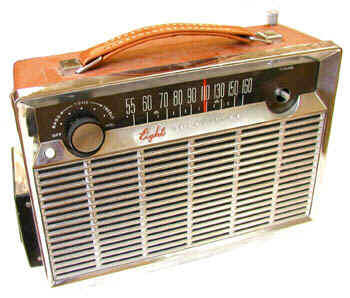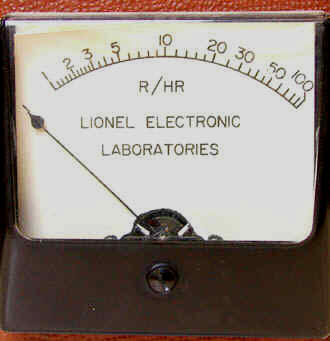CD V-726DX Prototype (ca. 1960)

What a neat idea, two essential fallout shelter items packaged together. A combination radio-civil defense meter! This Lionel prototype, the CD V-726DX, used the same type of GM detector as the CD V-726AX, another Lionel instrument. This is the same Lionel company that made toy trains. Learn more about Lionel's entry into the nuclear business.
Even though it employed a GM, the CD V-726DX had a relatively high range: up to 100 R/hr (the highest rate recommended by the Office of Civil Defense for the public). Unfortunately, I have no information about the "tricks" that were used to extent the GM's range this high.
The GM detector, located inside the case, operated continuously while the radio was turned on. The meter, seen on the left end of the case in the photograph, employed a non-linear scale—there was no range switch.

For what its worth, the radio was a General Electric Eight Transistor. That's how they described radios back then, by the number of transistors. My first radio was a Seven Transistor—a beautiful red and gold plastic job.
In 1956 the Sylvania company produced a combination radio-geiger counter called the "Prospector." The latter included a compass in case you lost your way and a sundial in case you needed to know the time. The model number was U-235. Cute.
The following quotes regarding the development of the combination radio-radiation detector are from an article that appeared in the July 9, 1959 issue of the Perry County Times:
“It is an established policy of the OCDM that every home should have a battery radio set. Also research carried out during the last year or more by the ABC [AEC] and OCDM has included attempts to perfect a radiation detection device which could be combined with the battery radio, hopefully at an additional cost of not more than $5 to $10.”
"The present general popular trend toward transistor radios, which are both portable and battery-owned, may, if the instruments are available at moderate cost, result in the introduction of fallout detection instruments into millions of homes."
“Several companies have developed such radio-radiation detector combinations which are being considered.”
I believe that the referenced companies included Westinghouse, General Electric, Heath and RCA.
Donated by the Federal Emergency Management Agency courtesy of Carl Siebentritt.
Reference
How Civil Defense Measures Harmful Radiation, Nucleonics, January 1962, p. 67-68.
